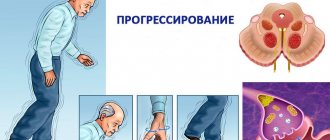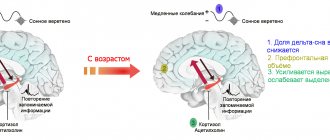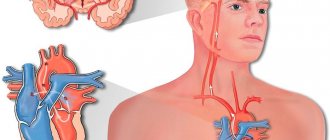Weakness in the legs or sudden awkwardness in movement after a hot bath may be symptoms of multiple sclerosis, an autoimmune disease of the nervous system that can lead to complete paralysis and blindness. In Russia, it is still confused with senile dementia and they are very surprised that both active young people and children are susceptible to it. On May 30, the International Day against Multiple Sclerosis, co-chairman of the All-Russian Union of Patients and president of the All-Russian Organization of Disabled Persons with Multiple Sclerosis, Yan Vlasov, told Taki Dela how patients with this disease live and what symptoms they need to pay attention to.
Photomicrography of the destruction of the myelin sheath of neurons of the nervous systemPhoto: Marvin 101/Wikipedia.org Yan Vlasov, MD, co-chairman of the All-Russian Union of Patients and President of the All-Russian Organization of Disabled Persons with Multiple SclerosisPhoto: from personal archive
What is multiple sclerosis
In multiple sclerosis, the immune system malfunctions and begins to attack the brain, damaging nerve cells. Sclerotic plaques - the connective tissue that remains at the site of such injuries - can appear in any part of the brain and spinal cord, which is why the disease is called multiple sclerosis.
Multiple sclerosis can develop in different ways: in one patient, exacerbations will be followed by complete or partial improvements, while in another, the disease will lead to complete paralysis within ten years. Scientists still do not know exactly why multiple sclerosis appears, but it is known that stress and strong negative experiences worsen the condition of patients, and positive emotions improve them.
In Russia, according to patient organizations, there are 150 thousand people with multiple sclerosis. The Ministry of Health register has three times less, just over 51 thousand people. This discrepancy appears because regional ministries of health, when providing data to the federal department, may take into account patients whose disease has progressed so far that medications will no longer help them, or may not take them into account.
Innovations to extend life
Dimyelization of the nerve fiber does not spare anyone - there are known cases of early onset of multiple sclerosis in children. Pregnancy can serve as an impetus for the development of the pathological process. Therefore, scientific work to create an effective medicine is being carried out by doctors all over the world.
Thus, Russian specialists have developed a vaccine against multiple sclerosis based on liposomes. They are able to stop the aggression of lymphocytes on myelin. The research results confirm the effectiveness and good tolerability of the drug in volunteers.
An innovative approach is the use of the patient’s own stem cells. They are isolated from biomaterial obtained from tissues before the start of powerful immunosuppressive therapy. The stem cells grown in the laboratory are then reintroduced into the patient’s body. The answer is an improvement in well-being and restoration of motor activity due to the correction of the myelin sheath of the nerve fiber.
Multiple sclerosis is not a death sentence at all. It can and should be dealt with, but in close cooperation with the treating neurologist.
How does multiple sclerosis manifest?
Multiple sclerosis is often called “the disease with a thousand faces” because its symptoms are not specific and can come and go.
“This is weakness in the limbs, especially worse after taking a hot bath or sauna, sudden attacks of incoordination without dizziness, recurrent visual impairment...,” lists Yan Vlasov. “All these symptoms are like a touch, they can even change during the day, they should alert a neurologist - this is where multiple sclerosis begins.”
It is a big mistake on the part of patients and their environment not to take these symptoms seriously and postpone a visit to a neurologist. If the doctor doubts the diagnosis, he can refer the patient to a center for help with multiple sclerosis. Information on regions can be found on the website of the All-Russian Public Organization of Disabled Persons with Multiple Sclerosis.
The hospital can diagnose multiple sclerosis within a maximum of three months - and this is a big step forward, because until recently the diagnosis took several years. But this level of medicine is available only in large cities; in rural settlements and small towns there are often no specialized specialists and the necessary equipment.
For almost twenty years, the Russian Committee of Multiple Sclerosis Researchers has been traveling to different regions and holding two-day schools there on all aspects of the treatment and diagnosis of multiple sclerosis. Thanks to this, there have been fewer cases where a sick person from a small town found out his diagnosis only a year or three after the first manifestation.
“We really hope that in the next six years they will create a system for standardizing specialized medical care specifically for patients with multiple sclerosis,” says Yan Vlasov. — If we create a standardization system, create first-, second-, third-level medical institutions that deal with this problem, we will be able to easily cover rural areas, and yet two-thirds of our citizens live there. [Currently] the number of part-time jobs there is very high, the equipment available is low, and to the nearest populated area where there is - I’m not talking about a tomograph, at least a specialized specialist! - 500 kilometers each.”
"You can't give up." Their illness came suddenly: how people with multiple sclerosis live
Millions of people around the world live with multiple sclerosis. This disease is insidious - it affects the human nervous system and can lead to disability. However, such people can live a full life, receiving drug therapy and psychological support. On May 30, the day of the fight against multiple sclerosis, Lenta.ru talks about the lives of people with this diagnosis.
Alina's life was cloudless and seemed predetermined. Her work record book bore the entry “ballet dancer,” and creative success and recognition awaited her. Therefore, when one day she stopped feeling her left leg, she thought it was something ordinary - perhaps a pinched spinal nerve. If so, you just need to go to a chiropractor, and everything will fall into place.
However, the chiropractor was unable to help Alina, and her condition did not improve. Something had to be done, and despite the fact that she really didn’t want it, Alina went to a paid clinic to see a neurologist, who prescribed her a referral for an MRI. It must be so. Alina remembers how she was placed in the machine and asked to get up in just a couple of minutes.
“You need to get an MRI with contrast,” the doctor said. Alina did not understand why this was necessary, but she agreed to this procedure, after which the doctors announced the presence of four lesions in her brain. After evaluating all the examination results, the doctor said that she had multiple sclerosis. “I thought: what kind of sclerosis is this, what are they coming up with? I’m actually a dancer, I need to go on tour! Of course, I started crying,” she recalls.
Photo: BSIP/Getty
The dance debut had to be cancelled, but somehow she did not change her life. After a short period of taking medications, the symptoms of the disease practically disappeared, and Alina decided that she could forget about multiple sclerosis. Alas, she was very mistaken.
“In 2015, I had another headache and stopped walking,” she recalls. “At first I denied all this. At the very beginning, after completing the course, I gave up on treatment: they said, it’s okay, it’s normal. Some understanding comes only later - there are five stages of accepting a situation: denial, anger, bargaining, depression, acceptance... I went through everything.”
The causes of multiple sclerosis are still not fully understood. This is an autoimmune disease - a disorder in the immune system that causes the body to attack its own tissues. In the case of multiple sclerosis, immune cells begin to attack cells in the nervous system, which disrupts the transmission of signals from the brain to the body. Alina’s example shows that if you do not pay attention to the disease in its early stages, it can lead to serious health problems.
People with multiple sclerosis can experience a wide range of problems, depending on how the disease progresses. This may be a deterioration in mental functions, and impaired balance, coordination and fine motor skills, impaired walking functions and the inability to move independently. All this interferes with living the way a person is used to
There are more than 2.5 million people in the world with multiple sclerosis. In Russia, the number of patients with this diagnosis is 150 thousand people. Although modern medicine is not yet able to definitively cure the disease, it can be controlled with the help of course-modifying drugs for multiple sclerosis (MSD). They can both reduce the number of relapses and slow down the progression of the disease, which means significantly delaying the onset of disability.
“Receiving DMT is a voluntary decision of the patient, but if treatment is refused, the disease progresses, the risk of exacerbations increases, and the patient’s condition worsens,” notes Stella Anatolyevna Sivertseva, head of the Multiple Sclerosis Center in Tyumen. She said clinical trials showed that patients who stopped treatment, compared with patients who continued to receive multiple sclerosis-modifying drugs (MSDs), experienced progressive worsening of their condition. Even after resuming treatment, they were unable to reach the same level as in patients who received DMT without a break.
But drug therapy is only part of a comprehensive treatment, and its maximum effect is achieved if the patient follows all the recommendations. It is necessary to adhere to a daily routine, proper sleep, and a proper diet. “You don’t need to avoid physical activity, but, on the contrary, do physical exercise on a regular basis, follow a work-rest schedule, and avoid chronic stress as much as possible,” notes Stella Sivertseva.
As an example, Sivertseva cites the story of her patient Alexander. Recently, his condition has been improving - after all, the correct drug therapy (DMT) was selected for him. Alexander believes that physical therapy sessions, which are conducted at the Multiple Sclerosis Center, also played a significant role in improving his condition.
Photo: Scott Broome / Unsplash
“Now Stella Anatolyevna has offered us a brilliant thing,” he continues. “This is dancing.” Sivertseva gathered willing patients into a group and attracted a choreographer. In essence, dancing is the same physical activity as exercise therapy, but, as Alexander says, during physical therapy you still have to force yourself to do the exercises, which negatively affects people’s mood. “When all this happens in dance, it is perceived as a game, it’s beautiful, you want to do it,” says the patient. “You learn steps, and this affects both motor memory and coordination of movements.” Now his group is learning tango.
To prevent multiple sclerosis from becoming an obstacle to a full life, you need to control your disease and adhere to doctors’ recommendations on therapy and lifestyle
The BETALIFE program, which turns ten this year, can help you organize your lifestyle correctly. It includes a 24-hour hotline, an Internet portal and a mobile application.
On the program’s website, the patient will be able to find webinars conducted by leading experts in the field of multiple sclerosis, as well as a series of useful brochures and informational articles about the disease. The BETALIFE mobile application allows users to keep a diary of their well-being and symptoms of the disease, as well as monitor the relationship between their lifestyle and condition and collect detailed statistics.
However, many patients do not immediately realize the importance of therapy, and Alina, who told her story, is a vivid example of this. Most often, multiple sclerosis is diagnosed in women (there are three times fewer men with this diagnosis) from 20 to 40 years old - that is, at the most active age, when people build a family life and career.
Photo: Geert Pieters / Unsplash
“When a person is diagnosed with any serious illness, a shock occurs, and his behavior can be described by the stages of grief according to Elisabeth Kübler-Ross,” explains psychologist Olga Vladimirovna Matvievskaya, president of the Interregional public organization of disabled people “Moscow Society of Multiple Sclerosis” (MosORS). First there is denial, and the person with multiple sclerosis says: “No, it can’t be, this is such a rare disease, no one in my family has had it.” He begins to look for some other doctors who will refute this diagnosis, or healers who are supposedly capable of magically curing him right tomorrow. Then, as each subsequent doctor confirms that this is indeed multiple sclerosis, after exacerbations of the disease, the patient comes to understand his diagnosis.
“This is a very painful stage - the bargaining stage. A person begins to think why he needs all this, why exactly he got sick, perhaps this is some kind of punishment,” continues Matvievskaya. The patient begins to look for reasons: for example, he believes that all this is due to the fact that he traveled to the south shortly before the diagnosis or got vaccinated. He bargains with himself, trying to bargain with himself for the lack of a diagnosis given to him.
The next stage involves understanding the inevitability of the diagnosis and realizing that it is for life. It is accompanied by depression. According to Matvievskaya, the doctor must monitor the person’s emotional state and possibly prescribe supportive treatment to relieve anxiety, frustration, and insomnia.
And only after these three stages does a person understand the inevitability and reality of the disease and can cross this threshold. He realizes the need to develop methods for treating the disease and tactics for coexistence with it. “It is from this moment that a positive attitude comes - and here it is definitely needed,” the psychologist emphasizes.
Alina did it. After she realized that she would have to live differently, she did not give up. “There’s no time to be discouraged,” she says. “When one door closes, another always opens, you just have to recognize it and catch it.” Alina realized that you can not only dance, but also teach children to dance. Now her students take first places in dance competitions. “I think for the sake of this - why not continue, gritting your teeth? But as? There’s plenty of ambition, and even more,” she smiles.
Photo: Mehrpouya H / Unsplash
It was difficult for Natalia, who received it ten years ago, to accept her diagnosis. “The understanding that you can’t give up came to me while I was in hospital for treatment,” she says. — My roommate had her diaper changed, and I realized that I didn’t want to do that. I have two sons, and I couldn’t allow this to happen—I want to take care of myself for the rest of my days. That was my goal."
For some time she walked with a cane, but thanks to strict adherence to doctors’ recommendations, Natalya can now ski and bike and even sometimes allows herself to wear high-heeled shoes. “You can’t quit therapy. This is a fall into the abyss, and it will be difficult to get out of there,” she warns.
Olga Matvievskaya is confident that a patient with multiple sclerosis can gradually achieve almost the same quality of life that he had before the disease
“Do you know Maslow’s pyramid? First, satisfaction of basic needs, and then personal growth, cultural, social, spiritual needs,” she says. Basic needs include quality and decent medical care and full drug provision. Then, when this goal is achieved, this is the quality of a person’s life, the extent to which he is able to live a full life. According to Matvievskaya, drugs are now prolonging this period.
Self-realization is also important so that one can coexist peacefully with this disease. As Alexander, a patient of Stella Sivertseva, says, you need to find something to do, no matter what. The main thing is to distract yourself from self-digging, which leads to depression. “Let’s say, I have a hobby: I like to learn and read poetry. Many people with my diagnosis complain of poor memory - so we need to develop it. It will become bad for any person if you don’t train your brain,” Alexander is sure.
Olga Matvievskaya notes that patients are now encouraged to start families. “They used to say that you can’t have children. No, it is possible and necessary to give birth and raise, to have a career, of course, taking into account all the neurological characteristics,” she says.
Photo: Andrew Neel/Unsplash
However, some employers are afraid to hire employees with multiple sclerosis, believing that they will have to pay for endless sick leave, and not hoping for the productivity of such an employee. “Yes, of course, with a severe course of the disease, problems may arise, but this does not mean that they need to be solved right now, and the person should be fired and denied self-realization,” Matvievskaya emphasizes. — All problems can be solved with the understanding and trust of the general public. Multiple sclerosis is not a death sentence; you can live and work with it.”
And it is not only possible to live, but, as patient Natalya is sure, it is necessary: the main thing is not to give up. To do this, you must completely trust the doctors, not give up treatment and strictly follow all recommendations. Don't forget that there is still a diagnosis. Not to adapt, but to accept and learn to live with it. “You can't give up. Giving up is the easiest thing to do in our case, but then there’s the wheelchair,” she says.
The interregional public organization of disabled people "Moscow Society of Multiple Sclerosis" (MosORS) together with the program for supporting patients with multiple sclerosis "BETALIFE" began collecting patient stories for the competition "How I fight multiple sclerosis." Tell us how you deal with the disease and what you can recommend to people with the same diagnosis so as not to give up.
How is multiple sclerosis treated?
Today, multiple sclerosis is considered incurable. However, with competent, properly selected treatment, you can improve the quality of life and extend the period without disability. If previously disability occurred three to five years after treatment, now with carefully selected therapy it can be delayed by 10, 15 and even 20 years. The lifespan of patients has also increased: now people with multiple sclerosis can live up to 72-75 years, whereas previously they died five years after receiving disability.
There is a particularly severe type of the disease - primary progressive multiple sclerosis. In such patients, at first there may be no obvious exacerbations, but the disease progresses twice as fast as usual and within ten years the person loses the ability to move independently and take care of himself. This year, the first and only drug in the world for this type of disease was registered in Russia - previously such sclerosis was considered incurable. According to a recent survey conducted by a public organization, 70% of neurologists admit that the drugs they previously prescribed to patients with primary progressive multiple sclerosis simply could not be effective. Now the main task is to ensure the availability of innovative therapy for all patients in need.
Patients with multiple sclerosis receive medications free of charge under the “Seven Nosologies” state program. However, as with any government procurement, there are interruptions in the supply of drugs - and then people who cannot stop therapy in order to prevent an exacerbation are left without drugs. A similar situation occurred in 2021. Interruptions still occur today - they are associated with irregular supplies, incorrect timing of the auction, or mismatching of the auction between the companies that supply the drug. “These are purely commercial matters that have nothing to do with the authorities or the patient. We are trying to ensure that there are fewer of these problems, but the greater the appetite of these structures, the more they are ready to gnaw each other’s throats, it is difficult to do something about it,” says Yan Vlasov.
Causes and provoking factors
Doctors have yet to determine the true cause of the development of multiple sclerosis in people. Today, only the role of immune mechanisms in the demyelinating process is obvious - the white matter of brain structures is more susceptible to damage.
Prerequisites for triggering an autoimmune failure:
- age factor - young people under 25–30 years of age are affected, less often signs of a nervous disorder are detected after 50–55 years of age;
- heredity - if there have already been cases of multiple sclerosis in the family, then the risk that the pathology will manifest itself in subsequent generations is high;
- suffered acute severe psycho-emotional shocks or chronic stressful situations;
- infectious lesions of brain structures that occurred with complications - meningitis, encephalitis;
- deficiency of vitamin D in the body;
- unfavorable environmental conditions - if a person lives in a metropolis for a long time, then the risk of developing MS is higher.
Statistically, multiple sclerosis affects both men and women equally. However, representatives of the fairer sex have a more fragile structure of the nervous system, so their incidence is higher. As a rule, in order for a pathology to form, exposure to several provoking factors is required.
Problems of patients with multiple sclerosis
According to a study by the Research Institute of Neurology ten years ago, the suicide rate among patients with multiple sclerosis was seven times higher than the population average. Now this figure, according to experts, has decreased, but the problem of social disorder remains. In three quarters of cases, patients with multiple sclerosis experience marriage breakdowns, and 80% of them are forced to look for a new job - taking into account their condition. “It’s mostly young people,” says Yan Vlasov. “The person is left alone: the children are still small, the parents are already elderly, there is no one to help him.”
Alexander Chernygin, 37 years old
guitar and yoga teacher
I am a musician by profession: I graduated from a music school, a college, an institute - all in classical guitar. Before his illness, he worked as a guitarist, performed at competitions, and won prizes. In 2006, I noticed that I began to play worse - the motor skills of my left hand became worse. I then thought: “Okay, I’ll stick to restaurants.” Such a game was no longer suitable for the big stage, but for the average level it was suitable. I was in demand as an accompanist. Therefore, when the first changes appeared, I did not rush to the doctors to find out what was wrong with my hands.
In 2011 I had a contract, I worked in Italy for six months. Then I started to feel a “storm”: I walked around like I was drunk, and it became clear that something had to be done. I took up my health: I started swimming, I became interested in yoga - it helps to keep myself in shape. I completely eliminated bad habits - smoking, alcohol - because I clearly felt that they had a bad effect. For example, I smoked a cigarette and immediately my fingers move worse. Same with alcohol.
The body speaks to me, and I understand what needs to be changed.
So, when it became clear what my diagnosis was, it did not cause a shock - by that time I had already listened to my body quite well, I had a certain attitude. It turned out that I intuitively did everything correctly.
It took about a year to figure out what was wrong with me. I was initially diagnosed with cerebellar degeneration because a poor-quality MRI scan was taken, and from the second scan it became clear that it was multiple sclerosis.
With the advent of the diagnosis, my life was divided into “before” and “after”. Before my illness, I was a musician, but became a teacher. Now I earn money by teaching guitar, yoga and receive a disability pension. Of course, compared to the times when I had a regular job, my income has dropped, but I can live.
It seems to me that the government does a pretty good job of helping us people with multiple sclerosis. For example, the medicine that I take costs 1.6 million a year, and I, of course, would not be able to afford it myself.
After I was diagnosed, I avoided traditional treatments for a long time because I read a lot about how “traditional medicine didn’t cure anyone.” And I wanted to be cured. I ignored the doctors, but in 2021 a serious deterioration began, and it became clear that I could not cope alone. I immediately told my mother and brother about my illness. Although it seems to me that they still don’t really understand what’s going on. For the most part I do this myself.
Now I have a “combined” regimen: twice a year I am injected with a drug that inhibits the development of MS, plus I regularly do yoga. In my opinion, if medications give you a more or less stable condition, then physical exercise can achieve some improvements. In theory, I should already be sitting in a wheelchair - but I walk on my own. With a cane, but on my own.
I communicate with other patients. There are communities on the Internet - we correspond, call each other, and I meet with some, including at yoga training. We discuss various means that can improve the condition, share tips and life hacks.
In 2021, I became a yoga teacher. I lead groups, but with healthy people. Caring for patients is a big responsibility; you need to learn this separately.
When I teach a class on the mat, it is absolutely incomprehensible that I am sick with something.
I was born in Kirov, lived in Perm. But I lived alone, and in 2017, when it became difficult to cope with everyday life, I had to move to Moscow: here I have a mother, a brother and his family, there is support. It’s difficult for me, for example, to go to the store. It is difficult to stand for a long time, and I can only look around while sitting.
By the way, it was the illness that pushed me to get my license. In 2015, walking became more difficult, and for a long time the car helped me out, I felt confident behind the wheel. However, during another exacerbation, my vision deteriorated, and since then I have not driven a car. But I am striving to get this skill back.
Before I had to stop driving, I worked as a guitar and harp teacher at the Dima Rogachev Children's Cancer Center. This is work in the field of hospital schools: it happens that children stay in the hospital for several years, but they need to receive an education. Guitar and harp were not required subjects, and for many children my lessons were more like music therapy. I trained them and saw that their well-being improved. I liked this work, and the children also enjoyed our classes. I myself benefited from this experience.
For a year and a half at the center, I saw children who, in a much more serious condition than me, continue to enjoy life, play, and love.
I had to leave this job when I stopped driving. I wouldn’t be able to go there on public transport, and even with tools. Now students come to my home, mostly children from neighboring houses in the Moscow region, where I live, and another girl with multiple sclerosis who comes from a neighboring village.
I'm not married, I didn't have time. Until 2011, I was married to a guitar, and then to an illness. At first I was completely captivated by music, but now I'm obsessed with health. Although there are plans, of course, to start a family. I am prepared for the fact that I may remain in this state as I am now for the rest of my days, but I will make every effort to get out.










